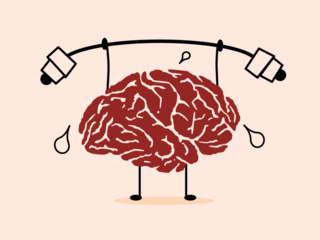Executive Function
Chocolate, Executive Function, and Luck
How chocolate (and a bit of exercise) could improve executive function.
Posted October 17, 2021 Reviewed by Jessica Schrader
Key points
- Executive function has been linked to luck and luckiness.
- Being able to improve cognitive executive function would be beneficial and has been the focus of much research.
- Both chocolate and moderately intense exercise may improve executive function.

Humans spend a great deal of time problem-solving. Planning what to do next, coming up with alternatives when our first plan doesn’t work out, organizing what we know, switching from solving a problem in one way to solving it in another, and inhibiting an incorrect response are all considered high-level, “executive” ways of thinking.
Being able to improve cognitive executive function would be beneficial and many researchers have focused their efforts in the laboratory on finding ways to do just this. And, improving executive function might also make us luckier people, more likely to notice that random opportunity when it comes along.
As it turns out, there are several things that have been shown to improve our executive function, and some of these methods are readily available and inexpensive, even free. Exercise improves not just the functioning of our physical bodies but also our executive function. And, happily for those of us who admit to being chocoholics, chocolate with its antioxidant characteristics can also improve executive function.
In a 2018 study, Tsukamoto, et al. examined the effect of cocoa consumption and exercise on executive function and memory in a small group of ten healthy young male college students. They chose to examine young college students because this particular population would be much less likely to suffer from cognitive impairments such as dementia and to be physically healthy, making the effects of both exercise and chocolate on normal cognitive function easier to detect and measure.
Executive function was examined using the Color Word Stroop test (a reliable test of the executive function of inhibition). Memory function was tested using the Face Name Matching test. Participants were allowed to familiarize themselves with both tests prior to the beginning of the testing sessions to minimize the effect of task learning on performance.

In the Stroop task, participants are asked to respond as quickly as possible to neutral, congruent, or incongruent stimuli. Neutral stimuli consisted of a color word like “PINK” written in black ink. A congruent stimulus would be one where a color word like “PINK” was presented in pink ink, and incongruent stimuli were color words printed in an incongruent ink color, like the word “PINK” written in green ink. Participants were asked to indicate the word presented in the neutral task and the color of the ink used to present the word in the incongruent task. Reaction time and accuracy provided a measure of the ability to inhibit the well-learned or “prepotent” reading response when tested with incongruent stimuli.
Memory was examined using the Face Name Memory test, where participants were shown images of faces paired with names and then later asked to verbally recall the name paired with a given face when shown the face alone.
Then the participants drank a beverage that was either low or high in flavanols, the antioxidant component of chocolate. Antioxidants are substances like Vitamins C and E, and flavanols that protect cells from the damage caused by free radicals.
Participants had their executive function and memory tested before consuming the chocolate drink, and then again 30 minutes and 60 minutes after chocolate consumption, immediately before 30 minutes of moderate exercise on a stationary bicycle. The cognitive tests were repeated again immediately following exercise, and at 30 and 60 minutes post-exercise. Consumption of high and low flavanols was counterbalanced with a 72-hour washout period between testing sessions. These were some very patient participants.
What they found was the consumption of a drink high in cocoa flavanols, but not the low cocoa flavanol drink, resulted in faster reaction times on the Stroop task. There was no significant effect on accuracy in the Stroop task for either high or low flavanol levels, or for exercise. The improvement in executive function could be seen as soon as 30 minutes after drinking the hot chocolate and remained present across all time periods. Cocoa flavanol level and exercise had no effect on performance on the memory task.
Exercise by itself also resulted in a significantly faster reaction time on the Stroop task. Consumption of a drink high in cocoa flavanols also improved reaction time on the Stroop task over and above the effect of exercise.
The conclusion the researchers came to was that the combination of consumption of high cocoa flavanols and moderately intense exercise effectively enhanced executive function. I think most of us already knew that exercise was good for us. It is nice to know that chocolate is actually good for us, too.
References
Tsukamoto, H., Suga, T., Ishibashi, A., Takenaka, S., Tanaka, D., Hirano, Y., Hamaoka, T., Goto, K., Ebi, K., Isaka, T., and Hashimoto, T. (2018). Flavnol-rich cocoa consumption enhances exercise-induced executive function improvements in humans. Nutrition, 46, 90-96.




